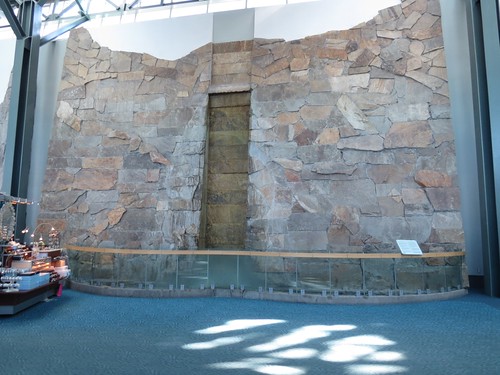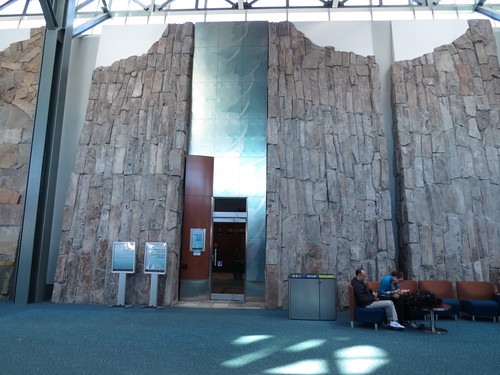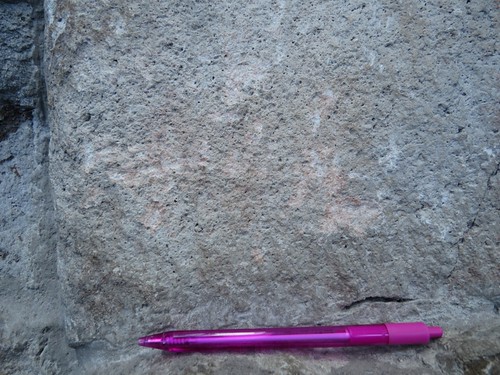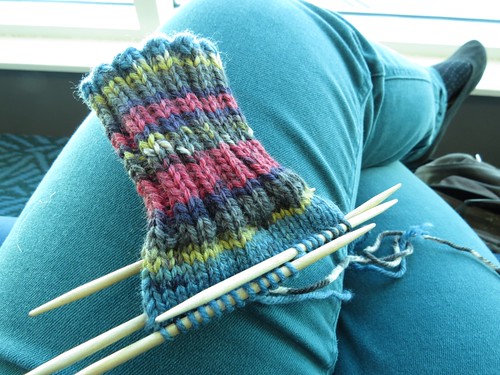 |
| Centre panel with waterfall. The rock here is the Garbaldi Golden Granite (actually granodiorite). |
So as an extremely bored geo, I thought I'd share it with you.
 |
| One of the two side panels (and the entrance to the Maple Leaf Lounge). The rock here is the columns of Rhyolite. |
THE SEA-TO-SKY WALL
Much of our mountainous west coast is formed of granite, an igneous rock. Here, molten magma crystallized far below the earth's surface to become one of the largest masses of granite in the world. North of Vancouver, Mount Garibaldi rose through the surrounding ice in a series of volcanic eruptions about 20,000 years ago, its granitic cone created by the cooling lava.
Displayed on this wall are two local varieties of igneous rock. The ways in which they evolved resulted in their different grain sizes, crystal shapes, mineral content, and colours. Both types of rock were quarried by Garbaldi Granite from unique deposits in the Squamish Valley, located near the Sea-to-Sky highway between Vancouver and Whistler.
Centre panel with waterfall:
Garbaldi Golden Granite is a coarse-grained rock known as granodiorite. Its large crystals of feldspar and quartz were created during the slow cooling of magma within the earth. The unusual golden colour of this granite developed over thousands of years, as iron-rich soils leached through its crevices. The rock is quarried without explosives; a wedging system is used instead to avoid cracks and damage.
Other [two] panels:
Rhyolite is similar in composition to granite, although it is more finely textured. It occurs naturally in 6-to-8 sided columns - the result of lava cooling rapidly at the earth's surface after a volcanic explosion. The columns are easily quarried by machine from their loose deposits.
I have to note, before I continue, that granite and granodiorite are entirely different rocks based on mineral content, so I'm a little annoyed with the description above. But oh well, granodiorite forms in a similar manner, it's only different chemical compositions of the magma itself that determines the rock type that forms. LET IT GO HEATHER.
 |
| Close up of granodiorite, bright pink pen for scale. |
 |
| Rhyolite columns. Bright pink pen for scale. |
 |
| Close up of the rhyolite. Bright pink pen for scale (you sick of me stating the obvious yet? Sorry but too bad, I'm stoked that I actually remembered to include a scale in my rock photos!) |
 |
| Cruising along on my sock! |
 |
| My view of Vancouver while writing this post. You're very pretty, Vancouver. Someday I'll visit more of you than your airport. |
Hi Heather,
ReplyDeleteGood post about the Sea To Sky wall. It was my favorite place at YVR, but located in a place where you're likely to hurry by. I'm a geologist too and it reminds me of when I was working as an exploration geologist and they would pay for my trips to and from camp every few weeks - I was always going through YVR. That was during the mining and exploration boom, around 2010, before economic problems in China caused problems in Canada. I hope things get better and I get to visit Vancouver again sometime. Thanks for the article
Clayton